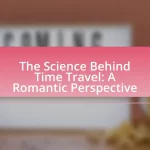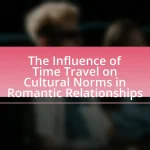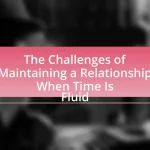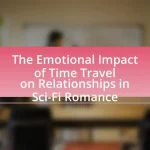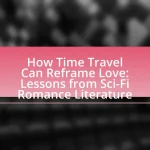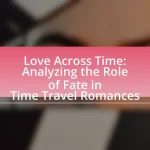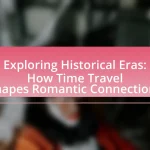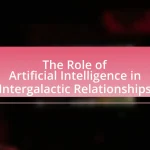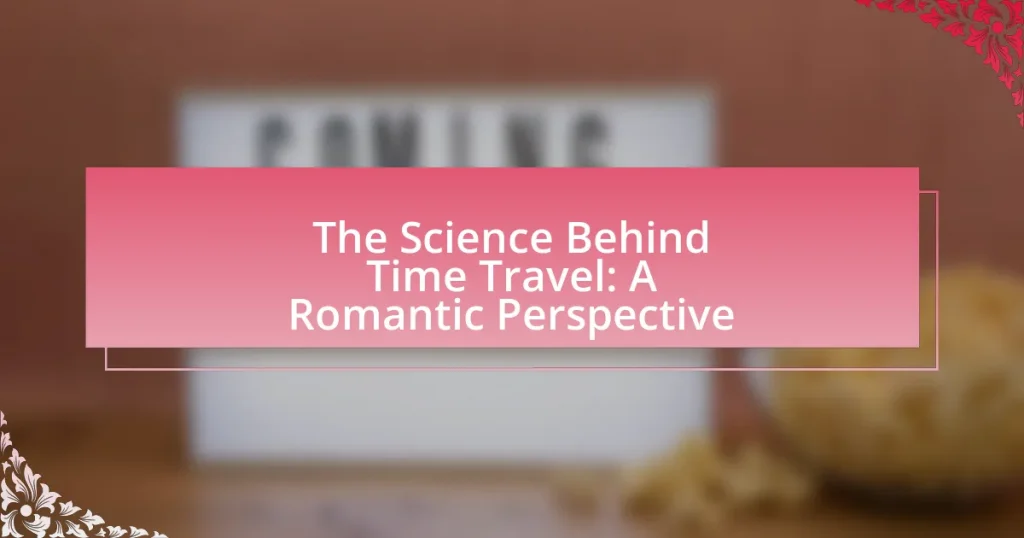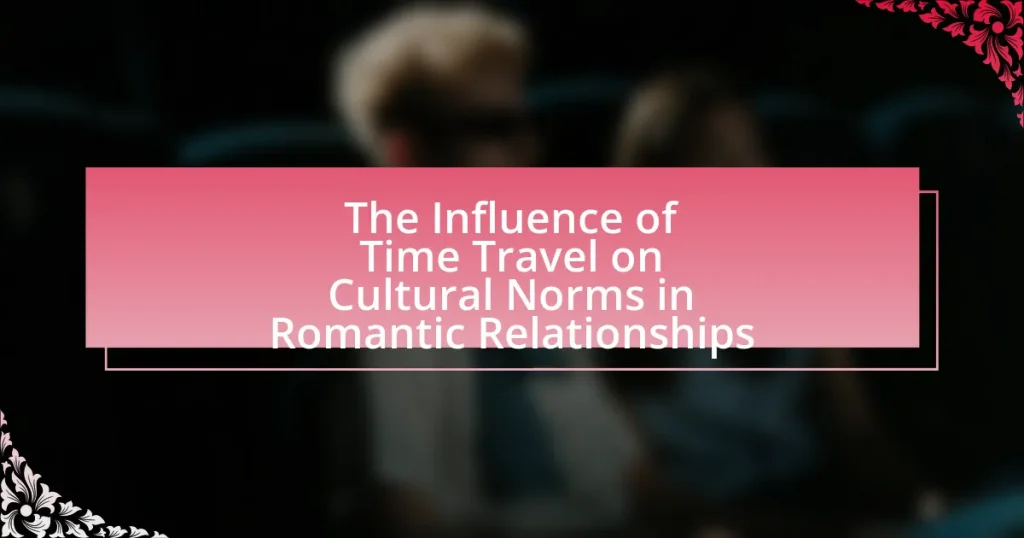The article explores the scientific principles behind time travel, primarily focusing on Albert Einstein’s theories of relativity, which suggest that time is influenced by speed and gravity. It examines various time travel theories, including time dilation, wormholes, and the implications of traveling to the past versus the future. Additionally, the article delves into the intersection of time travel and romance, discussing how these narratives enhance emotional connections, present ethical dilemmas, and reflect on the complexities of relationships across different timelines. Key examples from literature and film illustrate how time travel serves as a compelling device for exploring love and its challenges.
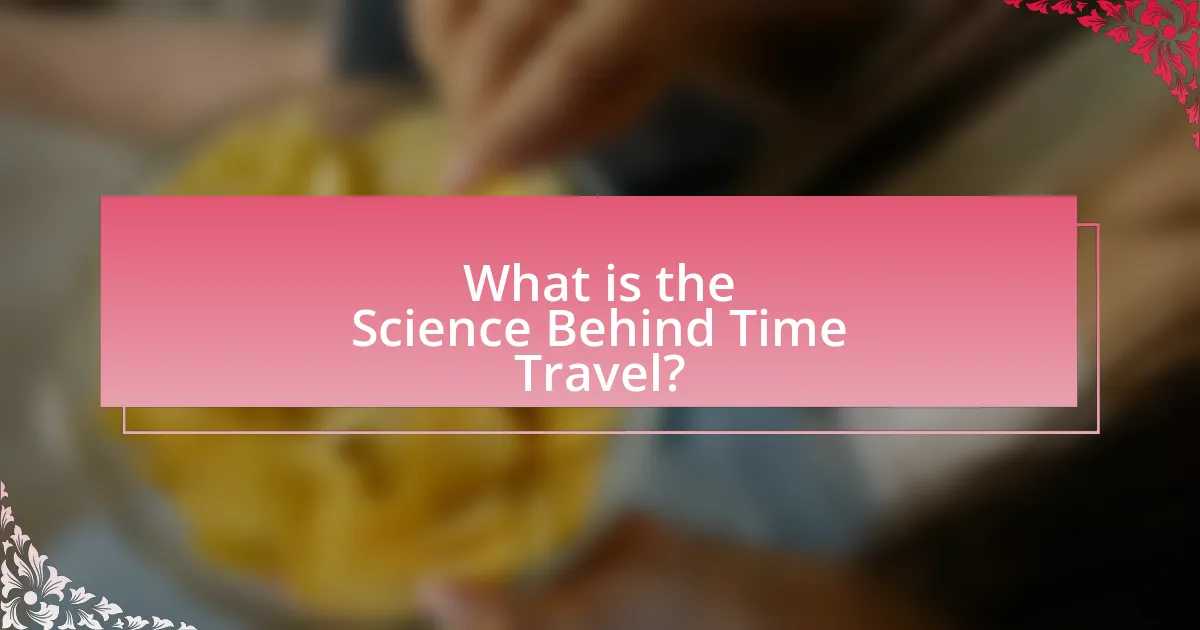
What is the Science Behind Time Travel?
The science behind time travel primarily involves the theories of relativity proposed by Albert Einstein. According to the theory of general relativity, time is not a constant and can be affected by factors such as gravity and speed. For instance, as an object approaches the speed of light, time dilation occurs, causing time to pass more slowly for that object relative to a stationary observer. This phenomenon has been experimentally validated through observations of particles moving at high speeds and precise measurements using atomic clocks on fast-moving aircraft. Additionally, concepts like wormholes and closed time-like curves suggest theoretical pathways for time travel, although these remain speculative and unproven in practical terms.
How do scientists define time travel?
Scientists define time travel as the concept of moving between different points in time, analogous to moving through space. This definition is rooted in the theories of relativity proposed by Albert Einstein, which suggest that time is not a constant and can be affected by factors such as speed and gravity. For instance, time dilation, a phenomenon observed in high-speed travel or strong gravitational fields, demonstrates that time can pass at different rates for observers in varying conditions, supporting the theoretical possibility of time travel.
What theories support the concept of time travel?
Theories that support the concept of time travel include Einstein’s Theory of Relativity, particularly the General Theory of Relativity, which suggests that time is affected by gravity and can be warped by massive objects. This theory implies the possibility of time dilation, where time moves slower in stronger gravitational fields, allowing for a form of time travel into the future. Additionally, concepts such as wormholes, proposed by physicists like Kip Thorne, suggest that shortcuts through spacetime could enable travel between different points in time. These theories are grounded in mathematical frameworks and experimental evidence, such as the observation of time dilation in particles moving at high speeds, confirming the validity of these time travel concepts.
How does relativity play a role in time travel?
Relativity plays a crucial role in time travel by demonstrating that time is not a constant but is affected by speed and gravity. According to Einstein’s theory of relativity, as an object approaches the speed of light, time for that object slows down relative to an observer at rest. This phenomenon, known as time dilation, suggests that if a spacecraft could travel close to light speed, the travelers would age more slowly than people on Earth. Additionally, strong gravitational fields, such as those near a black hole, can also warp time, causing time to pass more slowly in those regions compared to areas with weaker gravity. These principles indicate that time travel, at least in a theoretical sense, is possible within the framework of relativity, as evidenced by experimental confirmations of time dilation through precise measurements with atomic clocks on fast-moving jets and satellites.
What are the different types of time travel theories?
The different types of time travel theories include the following: the linear time theory, which posits that time moves in a straight line from past to future; the branching time theory, suggesting that every decision creates a new timeline; and the cyclical time theory, which argues that time is a repeating cycle. Each theory presents a unique perspective on how time operates and interacts with events. For instance, linear time is often supported by classical physics, while branching time aligns with interpretations of quantum mechanics, where multiple outcomes can exist simultaneously. Cyclical time has roots in various philosophical and cultural traditions, emphasizing the repetitive nature of existence.
What is the difference between time travel to the past and future?
Time travel to the past involves moving backward in time to experience events that have already occurred, while time travel to the future entails advancing forward to witness events that have yet to happen. Theoretical physics, particularly through concepts like wormholes and the theory of relativity, suggests that traveling to the past could lead to paradoxes, such as the grandfather paradox, where a time traveler might prevent their own existence. In contrast, traveling to the future is often considered more feasible within the framework of relativity, as time dilation allows for the possibility of experiencing time at different rates depending on speed and gravity. Thus, the fundamental difference lies in the implications and feasibility of altering past events versus observing future possibilities.
How do wormholes contribute to time travel theories?
Wormholes contribute to time travel theories by providing hypothetical shortcuts through spacetime, allowing for the possibility of traveling between different points in time. The concept of a wormhole, as proposed by physicists like Albert Einstein and Nathan Rosen, suggests that these tunnels could connect distant regions of space and time, potentially enabling time travel if traversable wormholes exist. Theoretical models indicate that if a wormhole could be stabilized and manipulated, it might allow an object to enter one end and exit at a different time, thus facilitating time travel. This idea is supported by the equations of general relativity, which describe how mass and energy can warp spacetime, creating the conditions necessary for wormholes to exist.
Why is time travel a popular subject in romance literature?
Time travel is a popular subject in romance literature because it allows for the exploration of love across different eras, creating unique emotional stakes and conflicts. This narrative device enables characters to experience relationships that transcend time, often leading to heightened romantic tension and the possibility of rekindling lost love or discovering new connections. The appeal is further supported by the notion that love can defy temporal boundaries, as seen in works like “Outlander” by Diana Gabaldon, where the protagonist’s journey through time leads to profound romantic experiences that challenge societal norms and personal choices.
How does time travel enhance romantic narratives?
Time travel enhances romantic narratives by allowing characters to explore relationships across different time periods, creating unique emotional dynamics. This mechanism enables the exploration of love that transcends time, as seen in works like “The Time Traveler’s Wife,” where the protagonist’s involuntary time travel complicates his relationship, adding depth and urgency. Additionally, time travel can introduce historical contexts that shape romantic ideals, as demonstrated in films like “Midnight in Paris,” where characters interact with iconic figures from the past, enriching their understanding of love. Such narratives often highlight themes of fate and choice, emphasizing how love can endure despite temporal challenges.
What are some famous romantic time travel stories?
Some famous romantic time travel stories include “The Time Traveler’s Wife” by Audrey Niffenegger, “Outlander” by Diana Gabaldon, and “About Time,” a film directed by Richard Curtis. “The Time Traveler’s Wife” explores the relationship between Henry, who involuntarily travels through time, and Clare, who waits for him in different timelines, highlighting the challenges of love across time. “Outlander” follows Claire, a World War II nurse who is transported to 18th-century Scotland, where she falls in love with Jamie Fraser, intertwining historical events with romance. “About Time” features Tim, who discovers he can time travel and uses this ability to improve his romantic life with Mary, emphasizing the importance of cherishing everyday moments. These stories effectively blend romance with the complexities of time travel, showcasing how love can transcend temporal boundaries.
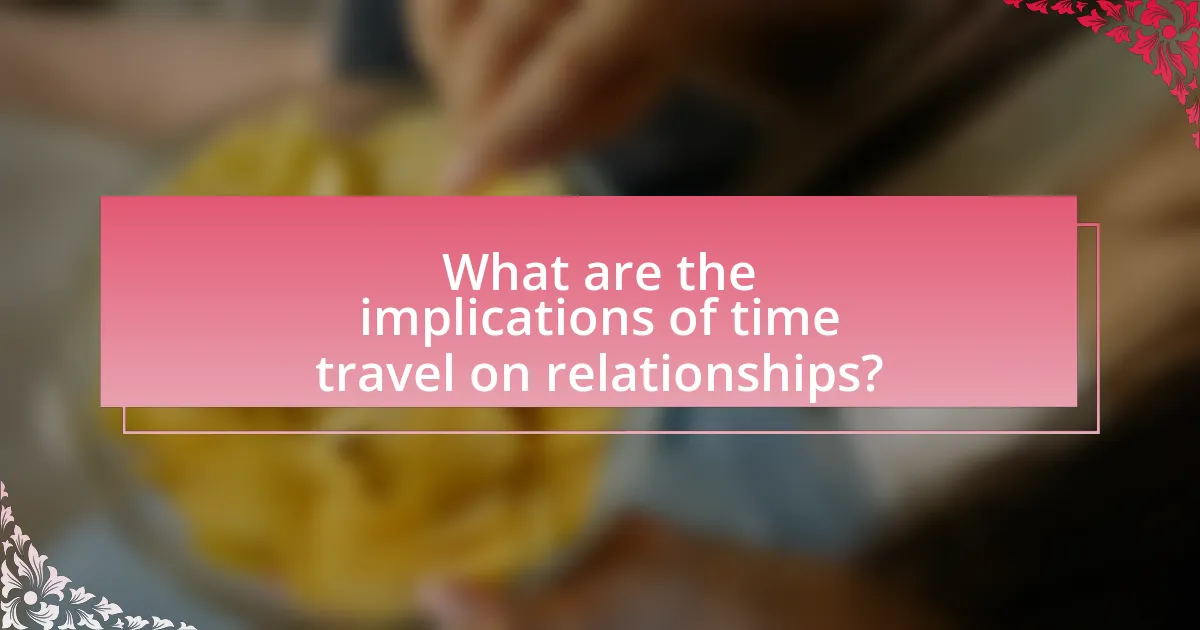
What are the implications of time travel on relationships?
Time travel can significantly complicate relationships by introducing paradoxes and emotional turmoil. For instance, if one partner travels to the past and alters events, it could lead to a scenario where their current relationship never existed, creating a causal loop known as the “grandfather paradox.” This paradox illustrates how actions taken in the past can have unforeseen consequences on present relationships. Additionally, time travel could lead to emotional strain due to the potential for jealousy or mistrust if one partner experiences different timelines or relationships in the past or future. These implications highlight the complex interplay between time travel and the stability of romantic connections.
How can time travel affect love and relationships?
Time travel can profoundly affect love and relationships by introducing complexities such as altered timelines and emotional conflicts. When individuals travel to the past or future, they may encounter different versions of their partners or themselves, leading to potential misunderstandings or emotional turmoil. For example, a person who travels back in time might inadvertently change events that affect their relationship’s foundation, creating a ripple effect that alters their current dynamics. Additionally, the concept of meeting a future partner could lead to feelings of longing or dissatisfaction with present relationships, as seen in various science fiction narratives. These scenarios illustrate how time travel could disrupt the stability and continuity essential for healthy relationships.
What challenges do time travelers face in romantic relationships?
Time travelers face significant challenges in romantic relationships primarily due to temporal dislocation, which creates barriers in communication and shared experiences. For instance, a time traveler may return from the past or future with different cultural norms, values, and expectations that can lead to misunderstandings with their partner. Additionally, the unpredictability of time travel can result in inconsistent availability, making it difficult to maintain a stable relationship. The emotional strain of potentially altering historical events or timelines can also create ethical dilemmas that complicate romantic connections. These challenges highlight the complexities of navigating love across different temporal realities.
How do different timelines impact emotional connections?
Different timelines can significantly impact emotional connections by altering the context and experiences shared between individuals. When individuals experience events in different timelines, their emotional bonds may weaken due to the lack of shared memories and experiences, which are crucial for building intimacy. Research indicates that shared experiences enhance emotional closeness; for instance, a study published in the Journal of Personality and Social Psychology found that couples who engage in novel activities together report higher levels of relationship satisfaction. Therefore, when timelines diverge, the absence of these shared moments can lead to emotional disconnection, as individuals may develop different perspectives and priorities that do not align.
What ethical dilemmas arise from time travel in romance?
Ethical dilemmas arising from time travel in romance include issues of consent, the potential for altering historical events, and the implications of emotional manipulation. When individuals travel back in time to engage in romantic relationships, they may inadvertently change significant events, leading to unintended consequences that affect not only their lives but also the lives of others. For instance, if a time traveler prevents a couple from meeting, it could erase future generations, raising questions about the morality of such actions. Additionally, the concept of consent becomes complex; if one partner is unaware of the time traveler’s true identity or intentions, the authenticity of their relationship is compromised. These dilemmas highlight the intricate balance between personal desires and the broader ethical implications of manipulating time in romantic contexts.
How does altering the past affect future relationships?
Altering the past can significantly disrupt future relationships by creating paradoxes that affect emotional connections and trust. When past events are changed, the foundational experiences that shape relationships may no longer exist, leading to confusion and potential conflict between individuals. For instance, if a pivotal moment in a relationship is altered, it can result in different emotional responses and expectations, ultimately undermining the bond that was originally formed. Research in theoretical physics, such as the “grandfather paradox,” illustrates how changes to past events can lead to inconsistencies in timelines, which can be metaphorically applied to human relationships, highlighting the fragility of emotional ties built on shared experiences.
What moral questions are raised by time travel in love stories?
Time travel in love stories raises significant moral questions regarding consent, the consequences of altering past events, and the ethical implications of manipulating relationships. The act of traveling back in time to change a romantic outcome can lead to scenarios where one partner’s autonomy is compromised, as they may not have the opportunity to make informed choices about their relationships. Additionally, altering past events can create unintended consequences, such as erasing existing relationships or causing harm to individuals who were not involved in the time traveler’s original timeline. These moral dilemmas highlight the complexities of love, choice, and the potential ripple effects of one’s actions across time.
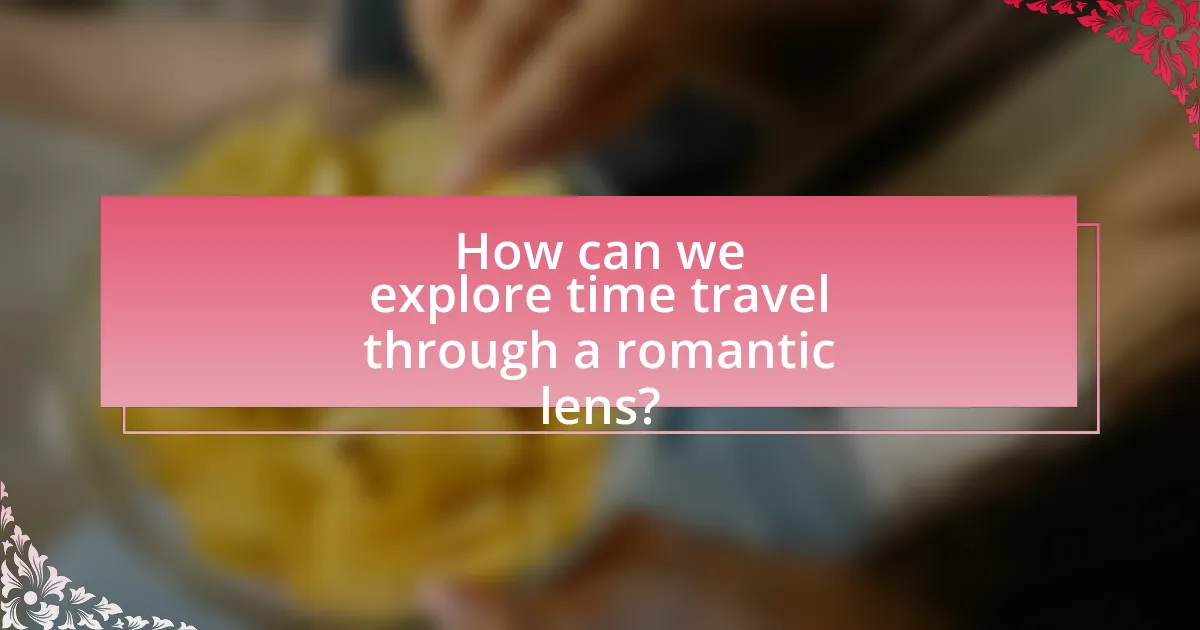
How can we explore time travel through a romantic lens?
Exploring time travel through a romantic lens can be achieved by examining the emotional connections and relationships that transcend time. Romantic narratives often utilize time travel to illustrate the enduring nature of love, as seen in works like “The Time Traveler’s Wife,” where love persists despite temporal dislocation. This concept is supported by psychological studies indicating that shared experiences, even across different timelines, can strengthen emotional bonds. Additionally, time travel in romance allows for the exploration of historical contexts, enabling characters to experience love in different eras, thus enriching the narrative with cultural and emotional depth.
What are the key elements of romantic time travel stories?
The key elements of romantic time travel stories include a compelling love story, the mechanism of time travel, emotional stakes, and the exploration of historical or future settings. A compelling love story serves as the central narrative, often featuring characters who are separated by time yet drawn together by fate. The mechanism of time travel, whether through technology, magic, or other means, is crucial as it enables the characters to traverse different eras. Emotional stakes are heightened by the challenges the characters face, such as the consequences of altering the past or the impossibility of their relationship. Lastly, the exploration of historical or future settings enriches the narrative, providing context and depth to the romance, often reflecting societal norms and values of the time periods involved.
How do character development and time travel intertwine?
Character development and time travel intertwine by allowing characters to experience growth through their interactions with different timelines and events. Time travel creates opportunities for characters to confront their past decisions, learn from alternate outcomes, and evolve in response to the consequences of their actions. For instance, in narratives like “The Time Traveler’s Wife,” the protagonist’s experiences across various time periods lead to profound emotional and psychological changes, illustrating how time travel serves as a catalyst for character evolution. This dynamic enhances storytelling by deepening character arcs and exploring themes of regret, redemption, and the impact of choices over time.
What settings are most effective for romantic time travel narratives?
Effective settings for romantic time travel narratives often include historical periods rich in cultural significance, such as the Victorian era or the Roaring Twenties. These settings provide a backdrop that enhances the romantic tension through societal norms and expectations, allowing characters to navigate love across time. For instance, the Victorian era’s strict social codes create obstacles that can intensify romantic connections, while the Roaring Twenties’ liberation offers a contrasting sense of freedom and excitement. Additionally, settings that juxtapose modernity with the past, like a contemporary character traveling to a historical event, can highlight the differences in romantic ideals and practices, making the narrative more engaging. Such settings not only serve as a canvas for romance but also deepen character development and thematic exploration, making them particularly effective in time travel narratives.
What practical insights can we gain from romantic time travel stories?
Romantic time travel stories provide practical insights into the complexities of love, relationships, and the impact of choices over time. These narratives often illustrate how decisions made in one time period can resonate through different eras, emphasizing the importance of communication and understanding in relationships. For example, in the film “The Time Traveler’s Wife,” the protagonist’s unpredictable time travel affects his relationship, highlighting the necessity of patience and adaptability in love. Such stories encourage readers to reflect on their own relationships, understanding that the past influences the present and future, and that love requires effort and compromise to thrive across time.
How can we apply lessons from time travel romances to real-life relationships?
Lessons from time travel romances can be applied to real-life relationships by emphasizing the importance of communication and understanding across different perspectives. In these narratives, characters often face challenges that require them to confront their past decisions and their impact on the present, illustrating how open dialogue can resolve misunderstandings. For instance, the film “About Time” showcases how time travel allows the protagonist to learn from his mistakes, reinforcing the idea that acknowledging and addressing past issues can strengthen current relationships. This reflects the real-life necessity of addressing unresolved conflicts to foster deeper connections and emotional intimacy.
What are some tips for writing compelling romantic time travel narratives?
To write compelling romantic time travel narratives, focus on creating strong emotional connections between characters across different timelines. Establish clear motivations for the characters’ time travel, ensuring that their journeys are driven by love or the desire to reunite with a partner. Incorporate well-researched historical or futuristic settings that enhance the romantic plot, allowing readers to immerse themselves in the time period’s culture and challenges. Additionally, maintain consistent time travel rules within the narrative to avoid confusion, and explore the consequences of altering timelines on relationships, which can add depth and tension to the story.
